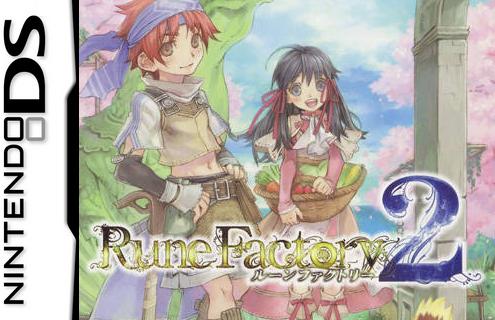Today we have a fine guest review from Frank Y. about the game Rune Factory 2: A Fantasy Harvest moon. If you happen to be interested in the Rune Factory series that has supposedly mixed the best parts of an action adventure role playing game, and a life simulator, but never really wanted to give it a chance. Consider reading this well though out review on the game and the series in general. Also let Frank know what you thought about his review.
The Rune Factory series excels most at its jack-of-all-trades take on the RPG-farming-dating-cooking genre. As its subtitle suggests, it is blessed with the roots and basis of Harvest Moon ”“ with a “fantasy” (role-playing) mutation. It takes what has been adored for two decades in the Harvest Moon series and reinvents it with the simplification of its farming gameplay, the addition of combat and jobs, and the expansion of romantic relationships and family.
Rune Factory 2 has fortunately adjusted the sexuality and lustiness of the original Rune Factory 1 characters to a less demeaning and more developed level. There are a number of more male characters, and the game appears less like a hentai dating simulator and more like an animeified Harvest Moon. It has expanded the cast to several young boys, one of transgender, as well as two non-dateable adult females (a nurse and swordsmith) that sum up to more than their measurements. The dateable females are developed with more depth than RF1, as well, with variety to their personalities and physical traits, as well as more respect to them as individuals. Most important is that you are given the chance to change genders and date males later in the game.
The farming gameplay has removed many of the difficult quirks of the original Harvest Moon series, while also decreasing its importance to the game drastically. Technically, it’s unnecessary to farm in Rune Factory. There are many options for making money: mining, part-time jobs, fishing, and battle. All of these are as much fun as you can derive from them. Likely, if you enjoy an MMORPG, then you’ll enjoy the gameplay of Rune Factory just as much. If you hate MMOs and prefer farming, then you can ignore everything else, too. While Rune Factory may not encourage extreme choosiness, it also does not hinder or prevent you from neglecting large sections of the game.
For farming, you’re provided the option of using fertilizer to speed up growth, as well as different areas (fall, winter, spring, summer) to harvest your crops of different seasons whenever you like. Seeds provide a great deal more amount of information than Harvest Moon games about their growth rate, sale cost, and difficulty of harvesting them. This is only one of the ways Rune Factory makes the series more approachable to new players, while also making it unnecessary to resort to a walkthrough in order to enjoy the game.
For combat and weaponry, you have a sizable amount of choice in how you fight. There are small and long swords, axes, hammers, wands, and spears. You can buy upgrades for them, add “Runes” (a tinier portion of the gameplay than the title would have you believe), and forge your own later in the game. The AI can be a surprising challenging, with quite a few different enemies ”“ one set for day, and one for night, each group designated to their ”˜season.’ The combat is of standard action-RPG fare, with a very solid engine.
The story can be thought of as on par with most any game from the 8 to 16-bit era (a thing few people have a problem with, still). Although it contains a large amount of text (and sometimes SOUND!) dialogue, the bulk of it is usually both dumb and irrelevant. Text conversations will loop at any given stage of friendship/romance with a character, so you must progress the relationship to ”˜unlock’ more conversations, and later, more gameplay. Other than this, you are placed into the game in a rather unceremoniously and blithe fashion: No name, amnesia, chance at being a part of their community, gifted with tutorials and tools, and a harem of young, single, fertile women at your disposal. All very orthodox to the JRPG genre.
However, it does serve its purposes extremely well ”“ that is, to provide a comforting home, social environment in a perfect farmtown utopia, with access to friendly characters and an interesting community to explore. Admittedly, Rune Factory 3 (and almost all other games, but RF in particular) would benefit greatly from conversational nonlinearity and option, giving the people and the relationships a vastly greater depth.
The environments and backgrounds of the areas are beautifully detailed with forestry, variation in ground detail, and other characteristic landmarks which make each area distinct and memorable. The village area has a really artful backdrop, which is always interesting to look over as you move down the street. The major issue with it, however, is that the individual doors and houses are difficult to distinguish from each other. The symbols over the doors and the shapes of the houses can be memorized, but it can be a little bit of a challenge to find what you’re looking for, for the first few days.
At the menu level ”“ its design is excellent. It’s clean, sharp, and intuitive. The character art close-ups add life to the conversations, with mood-changes and a cute style. The actually 3D models, in contrast, are rather like smudges of polygons. It’s a better idea to focus on the drawn animations.
Voice-acting wavers among entertaining, atrocious, and cute. It’s nice to hear full sentences spoken every once in a while, but there was obviously very little care put into finding appropriate actors (the same ridiculously deep-voiced man was used for multiple people.) Ultimately, the voice acting was not worth the expense invested by the company. The music is fairly background but does have a charming quality, ranging from area to area and serving to mark your entry into one place.
Rune Factory 2 is one of its kind, and is now one of the best series on the DS. There’s more variation and interesting activities to do here than on most others on the system.


